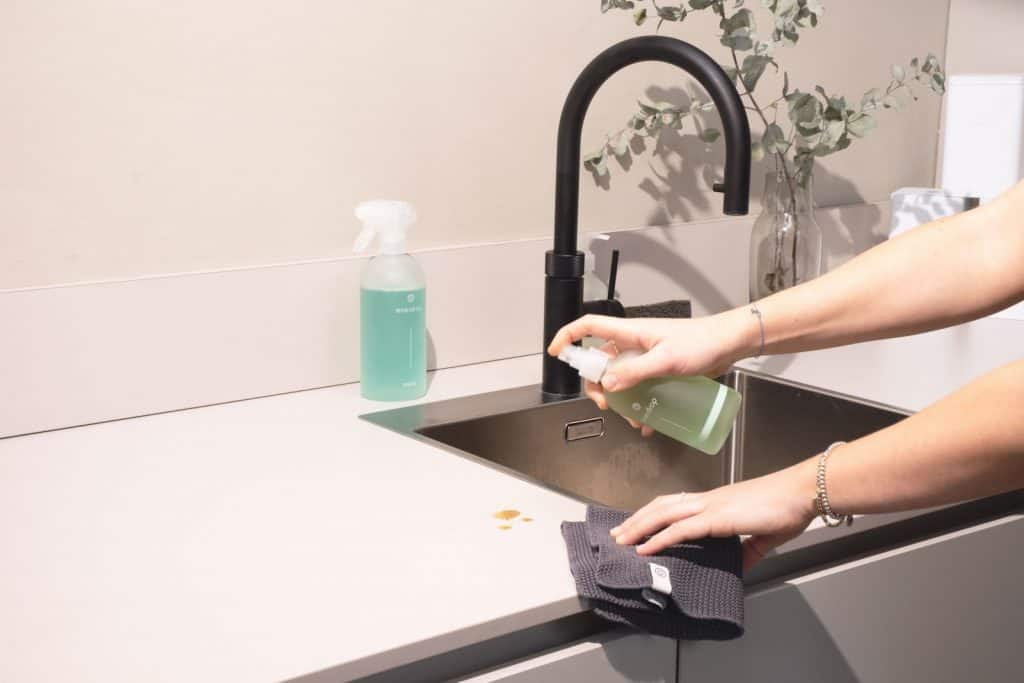You may run a clean kitchen, but like many of us, you may not give your kitchen sink and drain the attention they require. After all, aren’t we supposed to wash things in the sink and then rinse them out afterward? The natural assumption may be that we’re washing the sink as we go, correct? Wrong.
It’s time to learn how to clean kitchen sink drain the right way.
Your kitchen sink, like bathtubs and showers, gets filthy from washing dishes, pots, and pans. Grease, food particles, and other debris that settle on your dishes and utensils leave a filthy film on your sink—and a germ-infested breeding ground for germs and mold. Yuck!
How dirty is that kitchen sink? A clean, fresh-sanded bathroom sink has more germs than a flushed toilet! Ew. If you’ve ever opened the faucet and nothing but water shoots out, it’s possible that yours is clogged. Your kitchen sink may be the dirtiest room in your house—but before you go tearing off to grab your bleach, hear us out. The way to clean a kitchen sink drain, sink, and garbage disposal is important for a healthy, pleasant kitchen, but you don’t need harsh chemicals to do the job.
It’s important to clean out a kitchen sink, but getting rid of all that filth isn’t difficult. Baking soda, distilled white vinegar, and dish soap may all be used to clean a sink. The key is to clean your kitchen sink and kitchen drains on a regular basis enough to prevent slimy buildup, germs, and smells.
But what about the garbage disposal? Isn’t it full of germs, odors, and gross stuff as well? It is—and that’s why you’ll also learn how to clean a garbage disposal and keep it fresh right here. Let’s start with how to clean a stainless steel sink, and then go on to the finest methods for cleaning a kitchen drain and garbage disposer.

3 Simple Steps To Unclog Your Drains
Simply cleaning and disinfecting your kitchen sink doesn’t ensure that all germs and slime are gone. In your kitchen drain, you’ll find a slew of unpleasant things, including germs and scents. That’s because all of the grease, food, and other detritus that you wash off your plates and cooking equipment has to go somewhere.
When you know how to clean your kitchen sink drains correctly, you can decrease the amount of buildup that causes odors and germs. All you need is to sprinkle baking soda, distilled white vinegar, a lemon, and boiling water. Here’s how to do it:
- Bring two quarts of water to a boil. Slowly pour the boiling water down the drain with oven mitts on.
- Pour a cup of baking soda down the drain. Pour plenty of hot water from the sink over the sink and drain it well.
- Pour lemon juice or distilled white vinegar down the drain for additional odor removal. Rinse the sink and drain after 30 minutes.
How to Clean a Stainless Steel Sink
All you need to clean a stainless steel sink is baking soda, distilled white vinegar, and some scrubbing. Baking soda is a natural cleaning agent that’s safe for stainless steel. Distilled white vinegar is also a natural cleanser and disinfectant, and it’s safe to use on numerous surfaces and fabrics. For those looking to simplify their cleaning routine further, this guide on DIY cleaning solutions offers various natural methods.
Let’s get started cleaning stainless steel with nothing but natural cleaners, a soft nylon brush, and an old toothbrush.
- Fill the sink halfway with water and dish soap.
- Sprinkle some baking soda on the sink.
- Use a gentle scrub brush to work the baking soda in the grain’s direction.
- Use the toothbrush to clean around the drain hole and other difficult areas.
- All over the sink, spritz it with distilled white vinegar.
- Finally, rinse the sink with boiling water once the fizzing and bubbling have stopped. If you’re tackling other cleaning tasks, you might find this guide on how to clean a refrigerator useful for additional tips.
- A microfiber cloth should be used to dry the entire sink.
- Use a dry microfiber cloth to polish the stainless steel sinks.
Baking soda and vinegar work together to cut through greasy residue, disinfect, and dissolve calcium deposits that cause water spots. For similar cleaning advice, check out these tips on how to clean a shower head. If you have a porcelain sink, copper, granite, or cast iron sink, skip the scrubbing and just use dish soap and cold water with a towel instead. For maintaining various surfaces, consider exploring the benefits of how to clean under a very low bed for a comprehensive home cleaning approach.
How To Clean a Garbage Disposal
If you have a garbage disposal, you should clean it on a regular basis, just as you would the kitchen sink and drain. Even with a clean drain, grease, gunk, and food particles can build up on the blades, baffle, and other components of a garbage disposal if it isn’t cleaned regularly. It’s time to find out how to clean a garbage disposal and keep it that way if you want your kitchen sink to be totally clean.
A clean garbage disposal also means clearer drain pipes, so cleaning it on a regular basis lowers the likelihood of clog buildup. If you keep your garbage disposal clean, it should not be a problem. The majority of the time, though, your garbage disposal only needs to be cleaned about once a week. If you detect foul odors after cleaning your garbage disposal, it’s time for a cleaning. To keep your waste disposer and drains clean, follow these procedures:
Regular cleaning of the garbage disposal keeps it clean and odor-free.
- To avoid the disposal from operating while you’re cleaning it, turn off the electricity.
- If possible, unplug the disposal to minimize the chances of a clog while you turn off the water.
- To clean the underside and folds of the baffle, use a dish brush and an abrasive sponge.
- Spray any debris down the drain after rinsing the sink.
- Use a scrub sponge and dish soap to clean the top portion of the grinding chamber, rinsing as needed.
- Pour a handful of baking soda down the garbage disposal and allow it to sit for five minutes to absorb any remaining scents.
- Rinse the sink, drain it completely, and deep clean out the garbage disposal.
Lemon, kosher salt, and ice cubes do an excellent job of preventing build-up, odors, and germs during regular cleaning. Cut a lemon in half and place it in the garbage disposal with two cups of ice and two teaspoons of kosher salt. Turn on the faucet and listen to the lovely sound of buildup and scents being washed away as you run cold water tap over your sink.
Professional Cleaning
We all clean our house and sinks from time to time. It takes some effort, however, to do it correctly and thoroughly.
Consider hiring a professional cleaner on a weekly or bi-weekly basis if you believe that you don’t have enough time or skill to properly clean your sinks, toilets, and appliances. This will give you the assurance that those who know what they’re doing will clean and sanitize everything.

